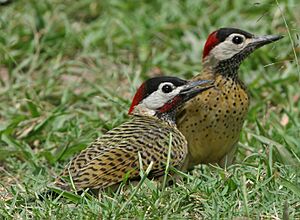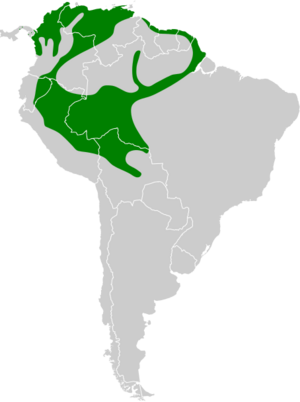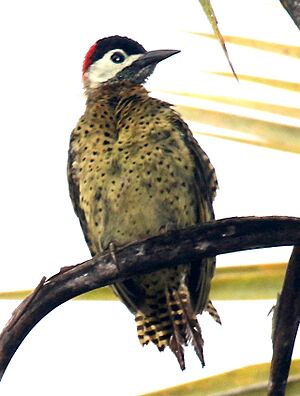Spot-breasted woodpecker facts for kids
Quick facts for kids Spot-breasted woodpecker |
|
|---|---|
 |
|
| Conservation status | |
| Scientific classification | |
| Genus: |
Colaptes
|
| Species: |
punctigula
|
 |
|
The spot-breasted woodpecker or spot-breasted flicker (Colaptes punctigula) is a type of bird from the woodpecker family. You can find this bird in Panama and most countries in mainland South America. This includes places like Colombia, Venezuela, Ecuador, Peru, and Brazil.
Contents
About Its Name
Scientists give every animal a special two-part name. This helps everyone around the world know exactly which animal they are talking about.
The spot-breasted woodpecker was first described in 1780 by a French scientist named Georges-Louis Leclerc, Comte de Buffon. He wrote about it in his book Histoire Naturelle des Oiseaux. Another scientist, Pieter Boddaert, later gave it its scientific name, Picus punctigula, in 1783.
For a long time, this woodpecker was placed in a group called Chrysoptilus. But now, scientists put it in the group Colaptes. This group name was given by an Irish scientist named Nicholas Aylward Vigors in 1825. The name Colaptes comes from an old Greek word meaning "chiseller," which is perfect for a woodpecker! The second part of its name, punctigula, comes from Latin words. Punctum means "spot," and gula means "throat." So, its name literally means "spotted throat"!
Different Types of Spot-Breasted Woodpeckers
Just like there are different breeds of dogs, there are different types of spot-breasted woodpeckers called subspecies. Scientists recognize six main subspecies:
- C. p. ujhelyii
- C. p. striatigularis
- C. p. punctipectus
- C. p. zuliae
- C. p. punctigula (This is the original type, called the "nominate" subspecies.)
- C. p. guttatus
What It Looks Like
The spot-breasted woodpecker is a medium-sized bird. It is about 18 to 21 cm (7.1 to 8.3 in) long, which is about the length of a pencil. It weighs between 50 to 79 g (1.8 to 2.8 oz), which is about as much as a small apple.
Both male and female woodpeckers look very similar. The main differences are on their heads.
- Males: Have a black forehead and the front part of their head. The back of their head and neck are red. They also have a red stripe on their cheek. Their chin and throat are black with white spots.
- Females: Only have a small bit of red on the very back of their head.
Both sexes have bronze-green feathers on their upper body with brownish-black stripes. Their lower back and tail feathers are lighter and have fewer stripes. Their wings are brown with light stripes and yellow shafts (the middle part of the feather). Their tail is brown on top. The underside of their tail is yellowish-brown with brown stripes.
Their belly feathers are a dull olive-yellow color. The upper part of their chest might have a reddish tint. They have small black spots on their chest and sides. The feathers under their tail are yellowish with black spots.
Their beak is dark, their eyes are reddish-brown, and their legs are greenish-gray. Young woodpeckers look a bit duller than adults. They have more green on their upper parts and bigger spots on their bellies.
How Subspecies Differ
The different subspecies have slight variations in their colors and patterns:
- C. p. striatigularis: Has a very white throat with a few black streaks. Its chest might be reddish, and it has quite a few spots on its belly.
- C. p. ujhelyii: Also has a very white throat with few streaks. It has a lot of red or orange on its chest. Its upper parts have fewer stripes than the nominate subspecies. Males often have a completely red head.
- C. p. zuliae: Is a bit larger than the nominate. It looks duller on top and has less black on its throat. It has fewer spots on its chest.
- C. p. punctipectus: Is greener on top than the nominate, without the bronze color. It has a black throat with large white spots. It looks duller below with fewer and smaller spots.
- C. p. guttatus: Has large white spots on its throat. It is very olive-colored on its chest and has more spots on its belly than the nominate.
Where It Lives
The spot-breasted woodpecker lives in different areas depending on its subspecies:
- C. p. ujhelyii: Found from eastern Panama to northern Colombia.
- C. p. striatigularis: Lives in west-central Colombia.
- C. p. punctipectus: Found in eastern Colombia and most of Venezuela (except the northwest).
- C. p. zuliae: Lives in northwestern Venezuela.
- C. p. punctigula: Found in the Guianas (like French Guiana) and Amapá in northern Brazil.
- C. p. guttatus: Lives in the Amazon Basin. This includes eastern Ecuador, eastern Peru, northeastern Bolivia, and western to northeastern Brazil.
This woodpecker lives in many different types of wet, lowland areas. It likes places that are open or have some trees, but it prefers areas with fewer trees over very dense forests. You can find it in rainforests, forests where trees lose their leaves, mangrove swamps, and even in areas with palm trees or coffee plantations. It usually lives at lower elevations, but can be found higher up in some areas. For example, in Colombia, it can live up to 1,500 m (4,900 ft) high.
Its Daily Life
Movement
The spot-breasted woodpecker does not migrate. It stays in the same area all year round.
What It Eats
This woodpecker eats almost entirely ants! It loves adult ants, their larvae (baby ants), and their pupae (the stage before they become adult ants). It usually looks for food in pairs or small family groups. They can search for food anywhere from the ground up to the middle levels of the forest. They mostly find food by picking it off surfaces or poking into cracks. On the ground, they might even sweep away leaves and dirt to find ants.
Reproduction
The breeding season for the spot-breasted woodpecker changes depending on where they live. For example, in Colombia, they breed from October to May. In the Guianas, it's from June to August.
Both the male and female woodpeckers work together to dig out a nest hole. They usually make their nest in a living or dead tree. Sometimes, they might even use a fence post! Scientists don't yet know how many eggs they lay, how long the eggs take to hatch, or how long the young birds stay in the nest.
What It Sounds Like
The spot-breasted woodpecker makes many different sounds!
- They have high-pitched, weak, and nasal calls that sound like "wha," "kah," or "keeh" in a series.
- When they are alarmed, they make a series of "peek" notes.
- When they are trying to attract a mate or challenge another bird, they make a "whew" whistle.
- They also have calls like "ta-wick" or "week-a" when they are showing off.
- They can make a fast series of "wick" notes.
- When a pair of woodpeckers meets closely, they make soft, low "pee-ya" calls.
Its Status
The IUCN (International Union for Conservation of Nature) has evaluated the spot-breasted woodpecker. They have listed it as a species of "Least Concern." This means that it is not currently in danger of disappearing.
This woodpecker lives in a very large area. Scientists estimate that there are at least half a million adult birds, and their population seems to be stable. No immediate threats have been found for this species. It is considered rare in Panama but is quite common in other places. Because it prefers more open woodlands, it is not too badly affected by forests being cleared.



